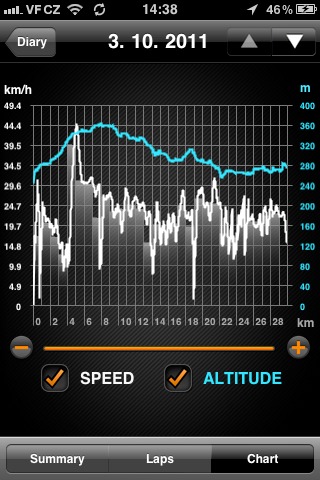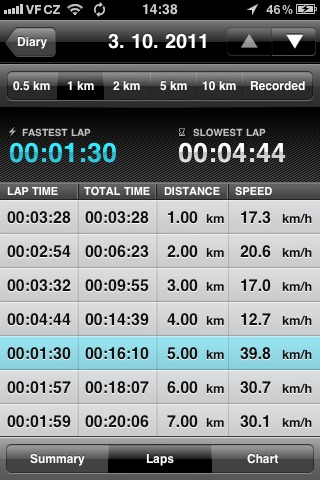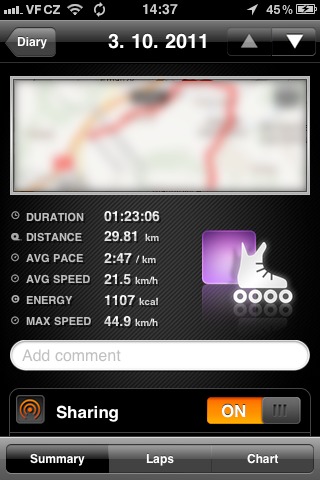Do you do sports? Do you like statistics and graphs? Then you must be using a GPS tracker. In this article we will look at Sports tracker, which I have grown to love over the past few months.
Even though I had very little time for sports this summer, I was able to log a few kilometers. For this purpose, I chose the Sports Tracker application, which is available for iOS, Android and Symbian platforms. After the launch of the Nokia N9, the application will also be available for MeeGo. Sports Tracker was created a few years ago under the wings of the Finnish Nokia. In 2008, I still had it as a beta version installed in my Nokia N78. In the summer of 2010, this project was sold to Sports Tracking Technologies. On July 8, 2011 came very exciting news - Sports Tracker in the App Store!
After launching the application, you are on the Home tab. You can see your avatar, the number of all tracked activities, total time, distance and energy burned. Below this mini-stat is displayed the last activity, notifications and remaining time until sunset. By the way, the last item is very useful information. Especially in autumn when the days are getting shorter. The lower orange button is used to start recording a new activity. You can choose from around fifteen sports and six free slots for the type you define. Sports Tracker offers an autopause function, which stops recording the route when the speed drops below a certain value. You can set 2 km/h, 5 km/h or recording without autopause.
The next tab is called Diary, in which all completed activities are listed chronologically, which you can also add here. There are many static trainers for running, cycling or rowing. It would certainly be a shame not to record all that hard work.
Each recorded activity is divided into three parts. In Summary, you can see a summary of the most important attributes – time, distance, average time per kilometer, average speed, expended energy and maximum speed. Above this statistic is a preview of the map with the route. The item Laps dissects the entire route into smaller parts (0,5-10 km) and creates special statistics for each part. Well, under the Chart item there is nothing but the height profile of the track with a speed graph.
In the settings, you can choose between metric or imperial units, turn on the voice response (especially useful when running) or the automatic lock immediately after the start of the activity. You can enter your weight for a better energy calculation. Editing your user profile is a matter of course. That would probably be all, as far as the application itself is concerned. Let's see what the web interface has to offer.
First of all, I must point out that the entire website sports-tracker.com is built on Adobe Flash technology. Thanks to the large monitor, you have the opportunity to better view the statistics and graphs of individual activities, which can be stretched across the entire display.
I really like the ability to compare a given activity with the best activity of the same sport and other statistics related to that one sport only.
Diary also uses a large display. You can view four months at the same time. If you've used another GPS tracker before, it doesn't matter. Sports Tracker can import GPX files.
You can share your activities via the social networks Facebook or Twitter. But Sports Tracker offers something more. It is enough to simply look at the map (not only) of your surroundings, in which you will see completed activities. You can then become friends with individual users and share your activities.
The only thing I miss in the Sports Tracker is the track elevation values - total, climb, descent. What GPS tracker do you use and why?
Sports Tracker - Free (App Store)



I ride a bike a lot and I tried Runtastic Pro, Run Keeper about 2 more which I don't remember and finally I ended up with MotionX which I've been using for about 2 years but this looks more than good - I'm going to try it :) Thanks for the tip.
For a long time I have been preparing an article about miCoach and Nike + GPS, which are slightly different applications. I only use them for running. As far as these multi-purpose apps go, Sports Tracker is one of the best.
The perfect feature is the wheels. If I remember correctly, the application automatically starts calculating the next circuit when you run through the beginning, and then you can see a perfect division into laps in the graphs - even if it should be, for example, 620 meters. The automatic stop when the speed drops is brilliant, and in addition, I think Sports Tracker uses GPS the best, no lags, everything immediately.
I just miss coaching, which is super useful when running. I admit that it is probably useless on wheelchairs.
Like a colleague - I ride a bike a lot and I was looking for a tracking application, but I found either paid versions with a free version, or free versions of poor quality and then I came across the free app SPORT TRACKER with which I am extremely satisfied, the processing quality is great, the application itself is already at a higher level and I can view the results in detail on the PC – SUPER! =)
I downloaded Sports Tracker a few days ago for a test, I used MapMyTracks, but it bothered me that browsing through saved workouts is extremely slow. So I always browsed on the web, or was patient. But what the guys with Sports Tracker showed is absolutely amazing. I haven't even found out yet that there is also a web interface (so thank you very much for the article), which is downright luxurious... This is exactly how I imagined it and I already know which application I'll stick with :)
Thanks again for the 'prompt' :)
I have a speedometer on my bike, I use MotionX for running etc. I transcribe the results from both and a lot of other activities into a table where I have picked up coefficients for each sport over the years, and every time I add the data with the current weight, it tells me how much energy I have burned. I've been running it for 3 years now, and when I throw it into Numbers, I can make incredible graphs in no time :-) Otherwise, the application looks very good, but the data on where I drove, ran or anything else (a map with the route) is useful for me in the future nothing. In my opinion, these data are only for the wow effect and to be viewed after an activity at rest on the sofa, up to a month ago. Anyway, I will try the application according to the article and the photos look really great.
One thing that bothers me about ST is that it is not possible to hide the map if the workout is shared on FCB. RunKeeper can do this.
I've been using Endomondo lately and it's very similar. It also shows elevation on the site. It also exists for Android. And it is also free, the paid version only contains some things that are not really necessary.
I use RunKeeper, for several months I also used Nike+GPS in parallel, but RunKeeper suited me better. I've tried Endomondo and it's good too. I'm not planning to switch to another app yet, my dad is more than enough for me.
how do I get my data from runkeeperpro to ST? Can you describe the procedure? Thank you.
Export each activity from the RunKeeper website to GPX and then import it separately on the Sports Tracker website. This is how I did it and I don't know of an easier way.
thanks Dan
Is there any chance on the iPhone when activity recording is running to have an Outdoor map that can be used for route planning?
The outdoor map is very detailed, but unfortunately it only offers Apple Standard, Hybrid or Satellite maps.
I had to change my phone and by downloading this app I am starting from scratch. Does anyone know how to find your profile???
How do I delete all activities on Sports Tracker?